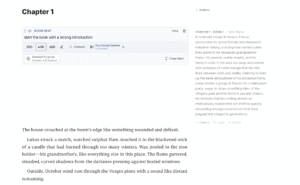What if you could turn hours of tedious research and data gathering into a polished report in a fraction of the time?
The right AI tool can change that equation, if you pick it deliberately.
In this article, we’re diving into the best AI tools for report writing.
| # | Tool (link) | Best for | What it does well | Pricing snapshot* |
|---|---|---|---|---|
| 1 |
Jenni AI
CitationsPDF uploads
|
Academic-style reports, citations & bibliography | Autocomplete-as-you-type, outline tools, library & BibTeX, 2,600+ citation styles, paraphrase & tone | Free (limited). Unlimited: $12/mo (listed on site). Team/Institutional: contact sales. |
| 2 |
Gemini Deep Research / ChatGPT Deep Research
AgenticCitations
|
Multi-step research with web + files + workspace data | Plans research steps, retrieves sources, produces structured, cited drafts; integrates with Workspace/Projects | Gemini Advanced via Google One AI Premium: ~$19.99/mo. ChatGPT Pro $200/mo (Deep Research & agent mode). |
| 3 |
Elicit
Evidence synthesisWorkflows
|
Evidence-based reports from academic literature | Semantic search (125M+ papers), screening → extraction → synthesis, traceable quotes & tables, exports | Free. Plus: $10/mo (annual). Pro: $42/mo (annual). Team/Enterprise available. |
| 4 |
Consensus AI
Peer-reviewedSummaries
|
Quick, cited answers from peer-reviewed research | Consensus meter, study summaries with citations, Ask Paper, Deep Searches for heavier reviews | Pro: $15/mo or $10/mo (annual). Deep: $65/mo or $45/mo (annual). Student/HCP discounts. |
| 5 |
Perplexity AI
Live webCitations
|
Current, cited answers & report sections from the web | Retrieval + synthesis with source links; Pro unlocks premium models, file uploads, deeper queries | Free. Pro: $20/mo or $200/yr. Enterprise tiers available. |
| 6 |
Slite
FormatterKB + AI
|
Clean up, format & co-write internal reports fast | AI Document Formatter, editor suggestions, knowledge base & search, templates, exports | Standard: $8/user/mo (annual). Knowledge Suite: $20/user/mo (annual). Enterprise: contact sales. |
| 7 |
Rows (Rows AI)
Data-drivenAI cells
|
Spreadsheet-first, data-rich reports with charts & text | AI cells (=ASK), CSV/PDF table extraction, cleaning, visualization, sharing/export | Free. Plus: $6/user/mo (annual) or $8 monthly. Pro: $59/mo + per-user fee. Enterprise: custom. |
| 8 |
Gamma
Docs/DecksFast layout
|
Rapidly turn prompts or drafts into polished doc/deck | Prompt→document/deck, card-based editing, themes, exports (PDF/PPT/Slides), team collaboration | Free. Plus: $10/seat/mo. Pro & Ultra tiers available (pricing shown in app/checkout). |
1. Jenni AI
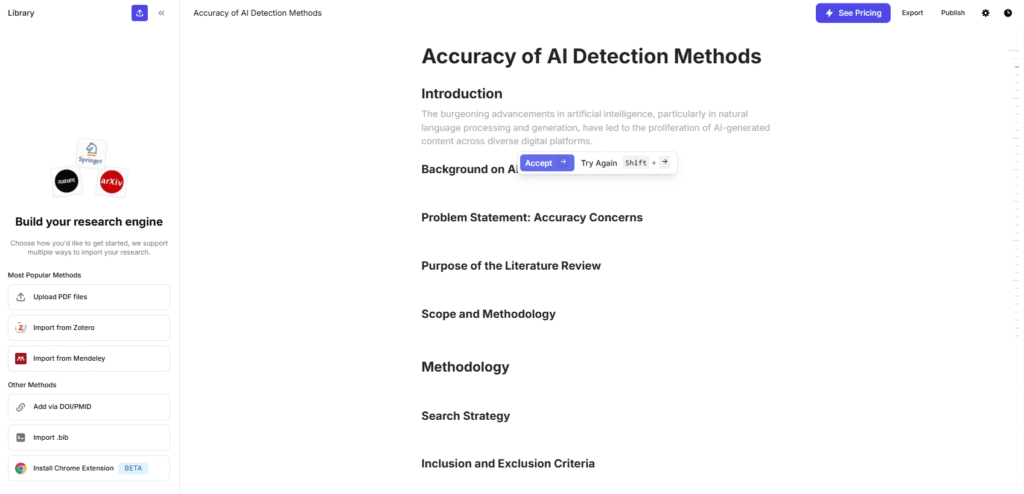
What is it?
Jenni AI is an AI-powered writing and research assistant that caters especially to academics and knowledge-workers. It supports uploading PDFs, citation generation and larger document workflows—making it a viable choice for report writing.
Features
Here are the features you’ll want to weigh:
- AI Autocomplete & Writing Assistant: Jenni provides sentence-by-sentence suggestions as you type, helping you overcome writer’s block, accelerate drafting and maintain flow.
- Research Library & PDF Upload: You can upload documents, import citations (BibTeX), use an internal library and ask the AI to reference specific sources or collections directly.
- Citation & Bibliography Integration: The tool supports thousands of citation styles, generates in-text citations and bibliography entries—valuable for formal reports that demand source referencing.
- Outline & Structure Tools: Jenni can propose outlines, section headings, and help you build logical structure before generating the detailed content.
- Paraphrasing, Tone Adjustments & Multilingual: You can ask Jenni to rewrite sections in different tones (formal, conversational) or in other languages (over 30 supported).
- Team/Collaboration Plans: For marketing teams or content departments, Jenni offers institutional/teams plans with collaboration, shared libraries and usage analytics.
Quality of the Report
- Strengths: Jenni helps build a first draft fast, especially when you supply uploaded sources. The structured approach (outline → section drafts) fits report workflows well. For example, the uploading of PDFs and built-in citations is a strong differentiator compared with standard AI writing tools.
- Limitations: Reports generated aren’t flawless out of the box. Sometimes it fabricates sources or mis-formats bibliographies. The line-by-line autocomplete can slow down bulk drafting compared to more free-flow editors.
- What it means for you: Use Jenni to generate major chunks of your report—draft sections, integrate research, build structure—but plan for your human pass: adapt brand voice, refine flow, verify sources and ensure the final piece speaks to your audience and meets SEO/marketing goals.
Pricing
Jenni AI offers tiered pricing:
- Free version: Basic access, limited word count (~200 words/day according to some reviews), limited PDF uploads.
- Paid plan (“Unlimited” or Premium): From about US $30/month (or ~$12/month if billed annually) for unlimited words/features (according to Textero review). Some 2025 reviews list ~US $30/month for “unlimited” access for research workflows.
- Team/Institutional plans: For organisations, pricing varies; enterprise features include collaboration, usage metrics and dedicated support.
2. Gemini Deep Research / ChatGPT Deep Research

What is it?
Gemini Deep Research is an advanced research-agent feature from Gemini (by Google DeepMind) designed to help you generate multi-page reports by combining web research, workspace documents (Drive, Gmail, Chat), and uploaded files. ChatGPT Deep Research is the same feature from ChatGPT (by OpenAI) that allows you to ask the AI to explore topics through multiple steps.
Features
- Gemini Deep Research: integrates with Google Workspace (Docs, Sheets, Gmail, Chat) and supports uploading attachments. You can select which data sources (web, Drive, Gmail) to include.
- It allows you to solicit interactive formats: for example, Gemini can create “Audio Overviews” of the report or embed visuals.
- ChatGPT Deep Research: leverages agentic tool-use (web search, follow-up questions, multi-step reasoning) to build a report with citations and structured sections.
- Both are designed for complex, multipart questions: not just “write a blog post,” but “analyse market X, compare with Y, produce a 5-section report with table and recommendations.” Gemini calls this “agentic mode.”
Quality of the Report
When handled correctly, these tools deliver high-quality reports with depth. For example:
- Gemini Deep Research can produce “insightful multi-page reports in minutes” by accessing your team’s docs, chats and emails.
- ChatGPT Deep Research has been reported to create reports of up to 5,000 words in about 5 minutes, synthesising hundreds of sources and providing citations.
That said, it’s not flawless: users note you still need to verify accuracy, adjust tone and apply brand voice.
Pricing
- Gemini Deep Research: Details vary depending on the Workspace plan and regional availability. The feature is included in Gemini Advanced / Workspace business subscriptions.
- ChatGPT Deep Research: the Deep Research feature is available to Pro users for ~US $200/month on top of the standard subscription. Free/Plus users get limited access. Plus at US $20/month, and Pro at US $200/month (which includes “maximum deep research and agent mode”).
3. Elicit

What is it?
Elicit is an AI-powered research assistant developed by Ought that focuses on automating evidence synthesis and structured reports based on academic literature.
Features
- Semantic research: Elicit searches across a database of 125 + million papers, using meaning-based queries rather than simple keyword matching.
- Structured workflows: Tools like “Reports” guide you through automatic search → screening → extraction → synthesis, and you can inspect and edit each step.
- Custom extract columns & data tables: For each paper you include, you can pull out methodology, population, findings, limitations—ideal for evidence-based report writing.
- Audit-trail & traceability: Every claim in the report links to the exact quote from the original source. You get transparency and verifiability.
- Collaborative and exportable: You can work in teams, adjust filtering criteria on-the-fly and export data tables or full reports for distribution.
Quality of the Report
Strengths:
- Depth & rigor: Elicit shines when you need research-based content—its structured workflows and citations elevate the credibility of your report. Elicit says its “Reports” feature outperformed some competitors on accuracy and speed.
- Time-savings: Compared with manually screening dozens of papers and extracting data, users report much shorter cycles. One case study found an extraction accuracy of “99.4%” when using Elicit for data points in a systematic review.
Limitations:
- Narrow scope: Many reviews note that because Elicit mostly searches academic papers, it may miss grey literature, non-academic sources or very recent studies.
- Not plug-and-play “finish report for me”: You’ll still need to edit the draft for tone, brand voice, marketing friendly language and integrate your own narrative.
- Mixed sensitivity: One peer-reviewed comparison found Elicit’s sensitivity (ability to capture all relevant studies) at ~39.5% compared with traditional search (~94.5%).
Pricing
Elicit has tiered access:
- Free plan: You can start with unlimited search across 125 + million papers, access basic workflows and generate simple reports
- Paid/Pro plans: According to reviewer summaries, paid tiers begin around US $30/month or more (depending on team size, export needs and advanced features) for research workflows.
- Enterprise customization: For organisations needing large export capacity, multi-user dashboards or private datasets, you’ll need to contact sales.
4. Consensus AI
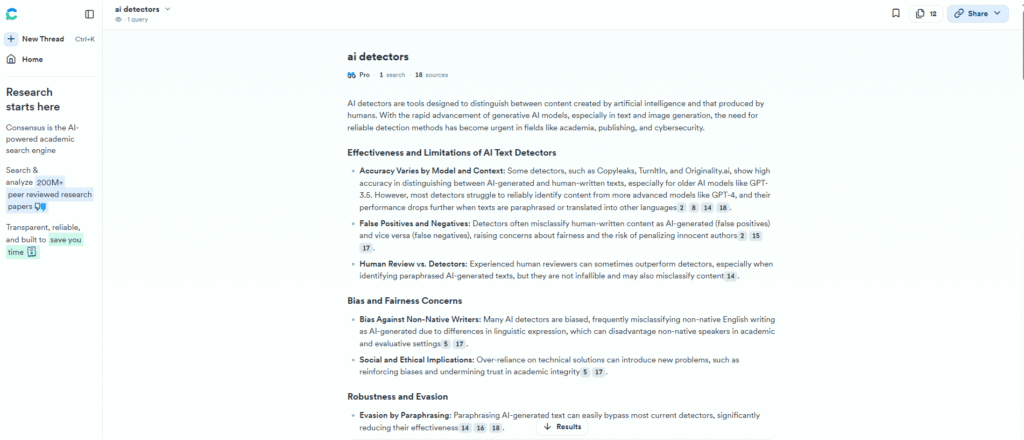
What is it?
Consensus AI is a research-focused AI tool that searches across peer-reviewed academic literature to provide evidence-based summaries and consensus insights. It serves as a powerful research engine to underpin your report with credible sources, clear findings and structured summaries.
Features
- Peer-reviewed source search: Consensus extracts insights from thousands of academic articles, filtering out much of the web noise typical in general search.
- Consensus meter / evidence strength: It provides visual indicators of agreement (e.g., how many studies support vs reject a given hypothesis), helping you gauge the strength of the evidence.
- Summaries with citations: Each summary they generate includes references, enabling you to trace back claims, which boosts credibility when writing reports.
- Research-friendly interface: Users can ask natural-language queries (for example: “Does intermittent fasting improve cognitive performance?”) and get a synthesis of relevant studies.
- Save/share functionality: The tool supports exporting findings, saving summaries and collaborating with team members—useful when converting research into report drafts.
Quality of the Report
- Strengths: If you’re building a report that requires credible sourcing (white-paper, industry trend analysis, internal strategy), Consensus gives you a head-start. Reviewers call it excellent for building an initial reading list. Because claims link to original studies, you reduce risk of fabricated data or unsubstantiated statements.
- Limitations: It’s not a “write entire report for me” tool. You’ll still need to craft narrative, tone, branding, visuals and flow. One reviewer noted the tool’s scope is limited when “you need automated meta-analysis” or niche domain content.
Pricing
- Consensus uses a freemium model: free access to core search and summary features, with paid tiers for heavier usage or advanced features.
- Paid plans are not always publicly detailed; reviewers suggest that for “frequent usage” or team access the upgrade is worth the time savings, but you’ll need to check live pricing for region and features.
5. Perplexity AI
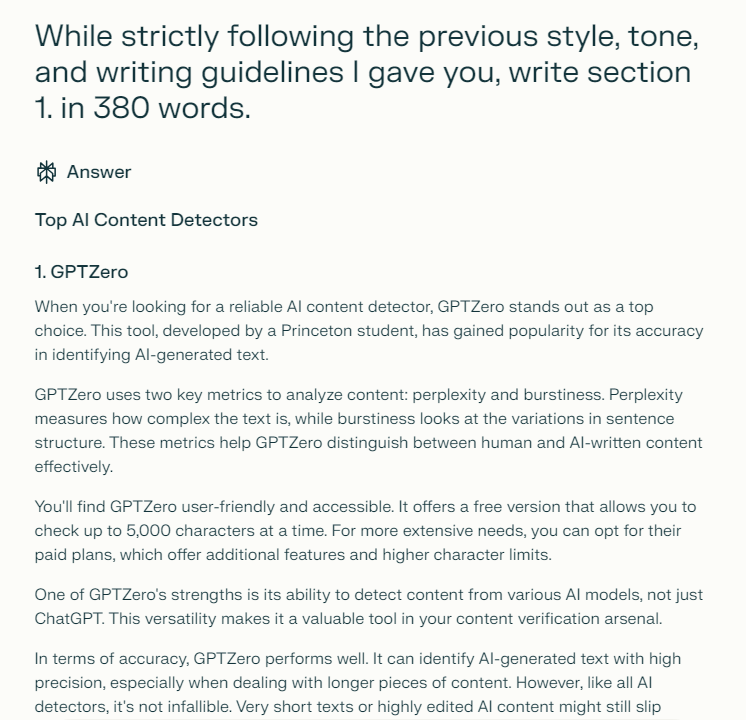
What is it?
Perplexity AI is a conversational search and research assistant that combines web retrieval with advanced language models to produce cited, up-to-date answers and summaries. It doesn’t just rely on a static snippet of training: it goes out, retrieves web information, and synthesises it into readable text.
Features
- Real-time web search with citations: When you prompt Perplexity, it returns text plus source links, enhancing traceability. A reviewer noted: “Its RAG process is highly visible… the term ‘answer engine’ fits.”
- Model switch / tiered access: Users on paid tiers can select from backend LLMs such as GPT-4o, Claude 3.5/Opus, o3-pro, enabling flexibility in depth and cost.
- File upload / context analysis (Pro version): Perplexity Pro supports uploading PDFs, CSVs and images for AI to parse and summarise – useful when your report includes internal documents or data sheets.
- Focused “Focus” mode / deep queries: You can guide Perplexity to dig deeper or adjust which sources it emphasises, giving control over output framing (e.g., “only peer-reviewed studies”).
Quality of the Report
Here’s how Perplexity performs and what you need to keep in mind when using it for report writing:
Strengths:
- Because it uses live web data, Perplexity can capture current facts, trends and research—making it far better than static LLMs for “what’s happening now” contexts.
- Reports or summaries you generate tend to be more credible thanks to linked sources—valuable when you’re crafting white-papers, executive briefs or reports for internal stakeholders who demand transparency.
Limitations:
- The generation still needs human oversight: one review flagged that although Perplexity “didn’t offer a vastly different experience for purely creative tasks,” it excelled at structured research tasks.
- Some studies show higher hallucination rates for reference generation with Perplexity compared with ideal benchmarks—e.g., in bibliographic retrieval tasks Perplexity scored less well than purpose-built research tools.
Pricing
- There’s a free plan: usable for light research, quick summaries and exploring the interface.
- The Pro plan starts around US $20/month (or ~$200/year) and unlocks premium models, file uploads, deeper queries and enhanced output.
- As a content marketing team, if you’re producing multiple reports a month and integrating uploads or premium LLMs, the Pro tier often becomes worth the cost.
- Note: Because pricing and features can shift (new plans, more credits, enterprise add-ons), always check the live site before budgeting.
6. Slite

What is it?
Slite is primarily marketed as an AI-powered knowledge base and collaborative document platform. While it isn’t a dedicated “report-writing AI” in the conventional sense, its AI Document Formatter and writing assistance features make it a viable tool for report production
Features
- AI Document Formatter: You can paste your draft content (for example an existing report) and let Slite’s AI “refactor” it into a clean, well-structured document—improving readability, breaking paragraphs into subheadings, bulleted lists and optimized layout.
- AI Editor (Writing Aid): As you write inside Slite, the AI suggests improvements—grammar, clarity, tone, simplification of complex sentences. The help article describes using the AI Assistant in the Editor to “jazz up your text, summarise it or suggest a better way to express something.”
- Knowledge base + search: You can build your team’s internal “single source of truth,” organize background docs, project plans and previous reports—all of which can feed into your next report and maintain consistency.
- Document templates & export: Slite provides templates for project reports, meeting minutes and internal documentation. You can export your documents and share them with stakeholders.
Quality of the ReportStrengths:
- Speed & formatting: The Document Formatter feature allows you to convert rough content into professional-looking documents in minutes, saving time on layout and structure. Users note that even “project reports” can be cleaned up fast with Slite’s AI.
- Readability: Because Slite’s AI emphasizes readability and audience awareness (“write to your readers,” “use sub-headings and bullets”), your final report is more accessible and less corporate-boilerplate.
- Team collaboration: You can pull in internal docs and knowledge base materials so your report draws on existing content, reducing duplication and improving internal consistency.
Limitations: - Research depth & external sourcing: Slite isn’t built for deep external research, large-scale citation extraction or heavy data-synthesis. If your report requires many external sources, statistical analysis or citation management, you’ll need to pair Slite with a dedicated research tool.
- Tone and brand voice still require manual editing: While the AI cleans up language, you still need to ensure the final report matches your brand voice, aligns with audience expectations and meets your SEO or marketing-narrative goals.
- Pricing scales with users: If you’re a large team or produce many reports per month, the per-user pricing can add up.
Pricing
Slite offers tiered, per-user pricing.
- Free plan: Typically for small teams starting out—document limits, fewer AI “Ask” queries, fewer integrations.
- Standard plan: ~$8/user/month (billed annually) (or ~$10/month monthly) for unlimited docs, core AI features and basic integrations.
- Premium / Knowledge Suite: ~$16-20/user/month (annually billed) for advanced AI (unlimited “Ask”), advanced integrations, custom domain, SSO and higher control.
For your content-marketing team: if you’re producing internal reports or briefing decks at moderate volume, the Standard plan may suffice. If you produce many deliverables or need full AI workflows and external integrations, the Premium tier is justified.
7. RowAI (via Rows AI)

What is it?
Rows AI is an AI-enhanced spreadsheet platform. Unlike the other tools, this one is built to handle data-driven reports where numbers matter, tables matter and insights must be clear.
Features
- Natural-language AI cells: Instead of writing formulas, you type something like
=ask("Summarize performance trends by month")and AI summarises the table for you. - Table/column operations: You can upload CSV/PDF, extract tables, clean data, append lookup columns, and pivot—all with AI assistance.
- Chart and visualization generation: From your spreadsheet you can ask AI “Create trend chart of revenue vs ad spend” and it delivers visuals ready for reports without switching tools.
- Real-time web enrichment: You can enrich your data with real-world facts (company data, locations, global facts) and even extract tables from images/screenshots/PDFs inside the sheet.
- Export and sharing: After building your data tables and visuals you can export them to PDF/web link and share with stakeholders, making it suitable for report production.
- Collaboration and team-oriented features: Because it’s built like a modern spreadsheet, multiple users can collaborate, making the tool suitable for marketing teams producing reports together.
Quality of the Report
When you build reports using Rows AI, here’s how it affects quality—and what to watch:
Strengths:
- Data-driven clarity: Since the tool is designed for spreadsheets, it excels when your report is grounded in numbers and tables. It reduces manual errors, formula mismatches and allows you to focus more on insight and less on data wrangling.
- Speed of insight generation: Many users cite how quickly you can go from raw data to “key findings” table or chart—significant time savings if you often produce monthly/quarterly reports.
Limitations: - Narrative & brand voice: Rows AI handles data and visual formatting well, but your storytelling (hook, audience-fit, persuasive narrative) still depends on your editing. If you load charts and ask “write insights,” the output is usable—but often generic; you’ll still need to refine tone, contextual framing and actionable recommendations.
- Research depth: If your report needs deep external research, discourse analysis, or heavy narrative context (e.g., “Why market X will shift”), Rows AI may be less suited; it’s best when you already have the data set and need to build a rigorous report around it.
Pricing
According to the site and independent listings:
- Freemium plan: Includes basic spreadsheet features and access to AI cells with usage limits.
- Paid plans: One review site lists starting pricing at US $20/month for the “Plus” plan with more AI operations and exports.
- Some mentions show a tier at US $14/user/month in earlier versions (via the pricing table seen in search results).
- Team/Enterprise options: For multiple users, live web integrations, higher limits and custom templates, you’ll likely contact sales.
8. Gamma
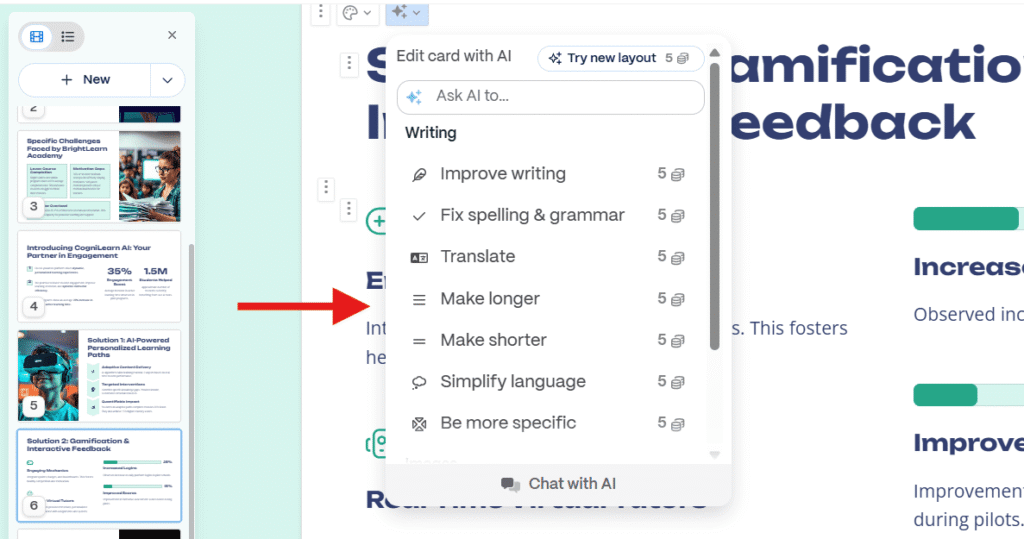
What is it?
Gamma is primarily positioned as an AI-powered platform for creating presentations and documents quickly. But it can also function as a rapid drafting and formatting tool—especially when the report format is flexible (e.g., web-friendly, slide-style, interactive).
Features
- Prompt → Document/Deck conversion: You can input text or upload a source and ask Gamma to “create a report” or document structure. It automatically generates headings, sub-points and visual layout.
- Card-based layout and swift editing: Gamma uses “cards” (akin to slides or content blocks) allowing you to rearrange, edit and regenerate sub-sections easily.
- Visual theme, tone and formatting controls: You can choose audience/tone, alter theme, pick export options (PDF, web link) and quickly get a polished output.
- Import/Export & team workflows: Gamma supports uploading documents or Clipboards, sharing links, and collaborating. For marketing teams, this means you can generate a draft report and share it with your designer/editor for polishing.
Quality of the Report
Here’s how Gamma performs—and what you should watch—when it’s used for report writing:
- Strengths: The tool excels at speed and layout. In one user test, a full “analytical report” draft was generated in minutes from a large input, with clear headings and near-publishable design. Because of its formatting and card system, you spend less time fiddling with design and more on content substance.
- Limitations: The content itself may require more editing than higher-tier research tools. Reviews highlight that Gamma’s initial drafts sometimes include generic language, miss domain-specific nuance, or require manual editing to refine tone and accuracy. Additionally, if your report demands deep research, citations or structured evidence extraction, Gamma will likely need to be paired with a stronger research-oriented tool.
Pricing
Gamma offers a tiered pricing model:
- Free plan: You start with ~400 credits (one-off) for trial use. Some users point out these credits can be depleted quickly when generating many cards/documents.
- Plus plan: ~$10/month (or ~$8/month if billed annually) giving you access to more creations, export features (PDF/Print) and removal of watermarks.
- Pro plan: ~$15-20/month per user for unlimited AI creation, advanced models and full export/import controls.
- Team/Enterprise: Custom pricing for large teams or brand-heavy setups (brand fonts, custom templates, enterprise export). Less defined in public domain.






